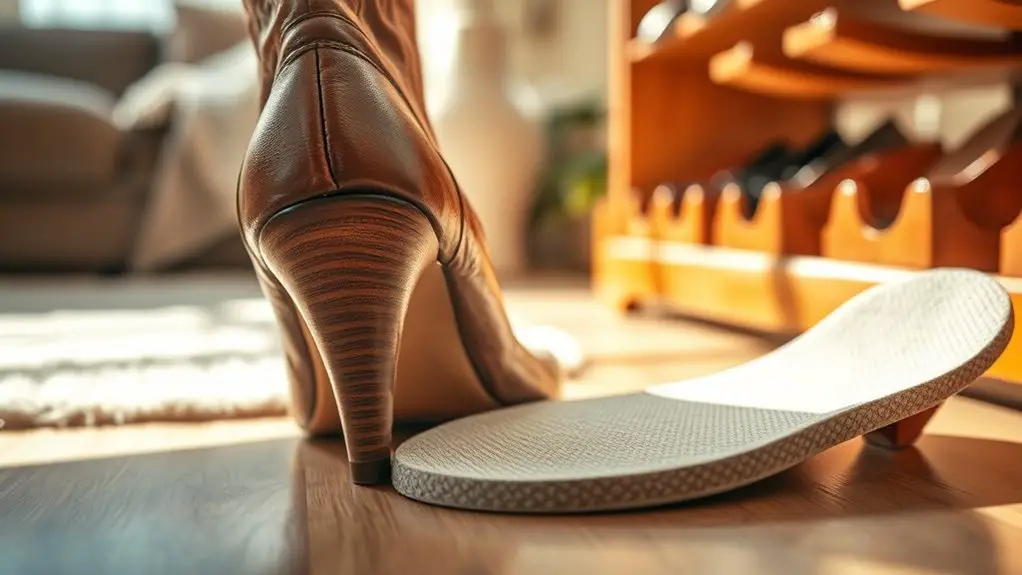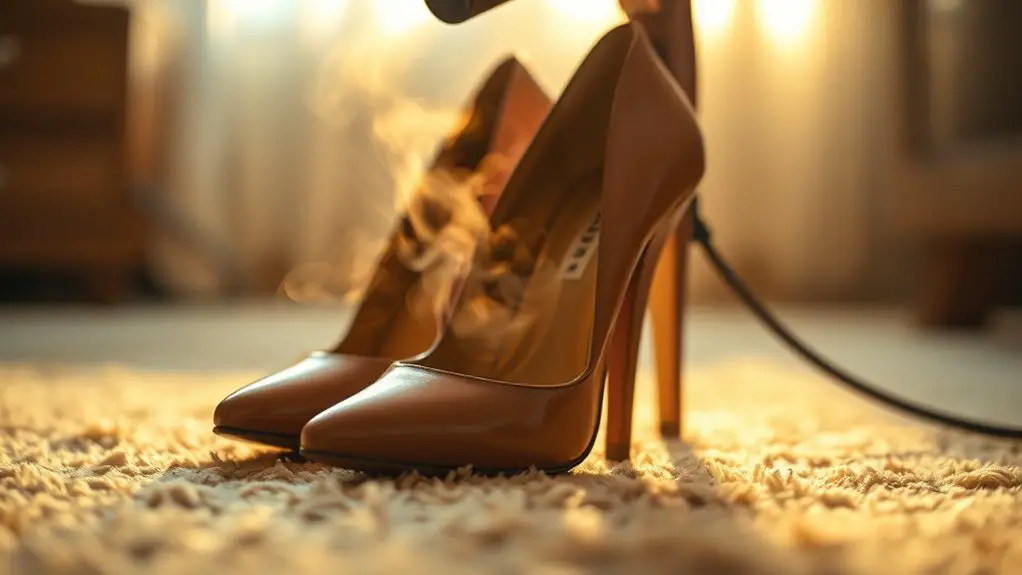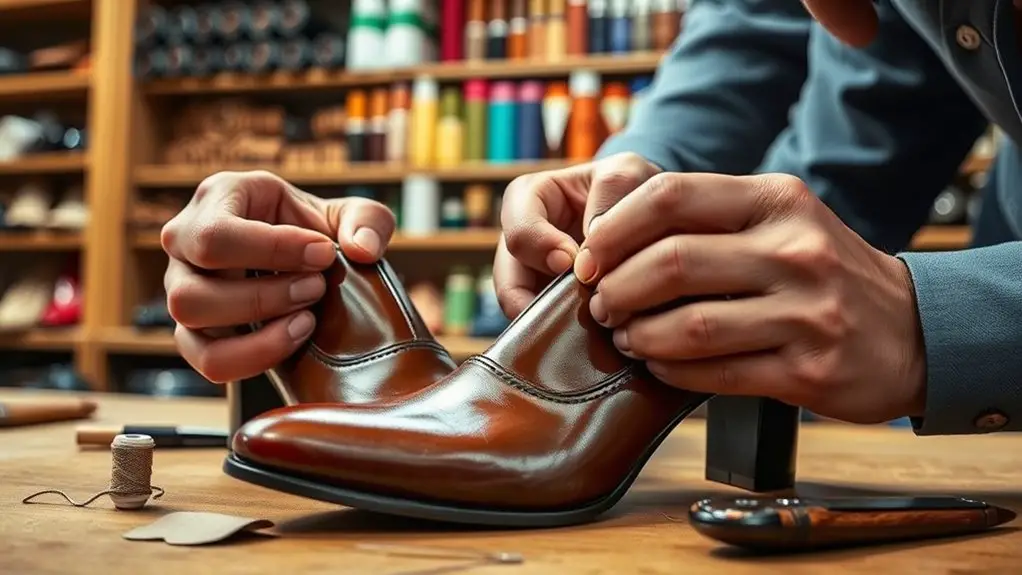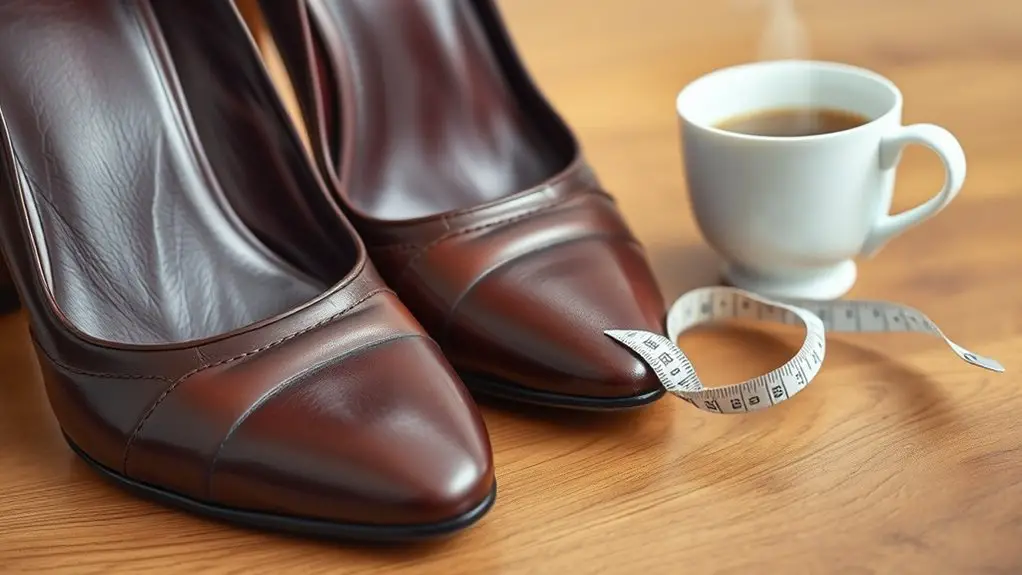To shrink heels that have become too loose over time, try the water method by placing a sealed plastic bag filled with water inside the heel and freezing it overnight. Alternatively, you can use heat to mold the materials back into shape with a hair dryer. Adding insoles or socks can enhance fit and comfort. For long-term solutions, consider professional shoe repair services. Keep going to uncover more tips on maintaining your footwear effectively.
Understanding Why Heels Become Loose

When you wear heels regularly, it’s not uncommon for them to become loose over time. Several factors contribute to this looseness, primarily the material wear of both the heel and the shoe structure. Continuous pressure from your weight can lead to the degradation of the adhesive bonds that hold the heel in place. Additionally, the materials used in heel construction—such as wood, plastic, or metal—can experience natural wear and tear, causing them to lose their original fit and stability.
Another cause of looseness is improper storage and care; exposure to moisture or extreme temperatures can weaken the materials. Furthermore, repetitive movements, such as walking or dancing, can exacerbate the wear on the heel. Understanding these causes of looseness helps you recognize when repairs or adjustments are necessary to maintain the integrity of your favorite pairs of heels.
The Water Method: A Simple Solution
Although it might seem unconventional, the water method offers a straightforward solution for shrinking loose heels. This technique capitalizes on water absorption properties to help your shoes regain a snug fit. Begin by filling a resealable plastic bag with water and make sure it’s securely closed to prevent leaks. Next, place the bag inside the loose heel, making certain it fills the space adequately.
Now, put the shoes in the freezer overnight. The cold water will freeze, expanding and gently compressing the shoe material. It’s vital to monitor the water temperature; using cold water is important, as hot water could damage certain materials. After the shoes have frozen, let them thaw slightly before removing the bag. This method effectively reshapes the heel, making it tighter and more comfortable for wear. Repeat if necessary, but always be cautious of the material’s limits.
Using Heat to Shrink Your Heels

Using heat is an effective method to shrink loose heels, and you have several options for heat sources, such as hair dryers or ovens. You’ll need to apply the heat carefully to avoid damaging the material of your shoes. Understanding the right techniques will guarantee you achieve the desired fit without compromising the integrity of your footwear.
Heat Source Options
To effectively shrink loose heels, it’s essential to select the right heat source. The correct heat application can help mold your heels back into shape. Here are three effective heating tools to evaluate:
- Hair Dryer: This common household item generates focused heat, making it easy to target specific areas of your heels.
- Heat Gun: For more precise heat application, a heat gun allows you to control the temperature, ensuring you don’t overheat the material.
- Boiling Water: Soaking the heels briefly in boiling water can soften the material, making it pliable for adjustment.
Using these heating tools effectively can help restore the fit of your shoes, ensuring they’re comfortable and secure once again.
Application Techniques
Once you’ve selected a suitable heat source, it’s time to apply the heat effectively to shrink your loose heels. Start by wearing thick socks to protect your feet and create a tighter fit. Then, using your heat source, aim the heat directly at the areas of the shoe that need to be shrunk. Move the heat source in small circles to guarantee even distribution, focusing on the heel area. Keep the heat moving to avoid damaging the material. After about 30 seconds, try walking in the shoes to gauge the fit. If necessary, repeat the process until you achieve the desired snugness. These application techniques are among the most effective methods for restoring your heels’ original shape.
Inserting Insoles for a Snug Fit
To achieve a snug fit in loose heels, selecting the right insole is essential. You’ll find various types of insoles designed for different needs, such as cushioning or arch support. Knowing how to properly insert these insoles can enhance comfort and stability in your footwear.
Choosing the Right Insole
When you’re dealing with loose heels, choosing the right insole can make a significant difference in achieving a snug fit. The right insole helps with stability and comfort, while also providing essential arch support. Consider the following factors when selecting your insole:
- Insole Materials: Look for durable materials like foam or gel, which can offer cushioning and resilience.
- Arch Support: Guarantee the insole provides adequate arch support that aligns with your foot structure, improving overall fit.
- Thickness: Choose an insole thickness that fills the gap without causing discomfort, guaranteeing a snug yet comfortable fit.
Types of Insoles Available
Selecting the right insole is just the beginning; understanding the various types available can further enhance your shoe fit. Gel insoles are a popular choice, providing cushioning that absorbs impact and adds comfort, especially during long periods of wear. They’re particularly advantageous for those seeking immediate relief from discomfort. On the other hand, insoles offering arch support are essential for maintaining foot alignment and distributing weight evenly. This is vital for preventing fatigue and discomfort in the arches. Depending on your specific needs, you might choose a combination of both types to achieve a snug fit. Proper selection of insoles tailored to your foot’s requirements can greatly improve the overall fit and feel of your shoes.
Proper Insertion Techniques
Although inserting insoles may seem straightforward, proper techniques can greatly enhance their effectiveness in providing a snug fit. For best results, follow these steps:
- Choose the Right Insole: Confirm your insole matches your shoe size for proper shoe fitting and support.
- Prepare the Shoe: Remove the original insole, if applicable, to allow for effective stretching and to create space for the new insole.
- Insert with Precision: Place the insole gently into the shoe, aligning it with the heel and toe areas. Make sure it lies flat without any bunching.
The Role of Shoe Inserts and Cushions
Shoe inserts and cushions play a crucial role in addressing loose heels by providing additional support and stability. When you add inserts, you’re fundamentally enhancing the fit of your shoes, which can greatly improve comfort. One of the key insole benefits is that they help fill the gap between your foot and the shoe, preventing excessive movement that could lead to blisters or discomfort.
There are various cushion types available, such as gel, foam, and air-infused options, each offering unique levels of softness and support. Gel inserts, for instance, provide excellent shock absorption, making them ideal for those who spend long hours on their feet. Foam inserts tend to be more lightweight and breathable, while air-infused cushions offer a plush feel. By selecting the right combination of inserts and cushions, you can effectively minimize heel slippage and enhance your overall shoe experience.
Professional Shoe Repair Options

If inserts and cushions don’t fully resolve the issue of loose heels, professional shoe repair options can provide a more permanent solution. By utilizing expert services, you can restore the fit and functionality of your favorite footwear. Here are three professional services to evaluate:
- Heel Replacement: A cobbler can replace worn-out or damaged heels, ensuring a snug fit.
- Resizing: Professionals can adjust the size of the shoe, making it tighter around the heel area to enhance stability.
- Reinforcement: Adding materials to the interior of the heel can help secure your foot better and prevent slipping.
Investing in professional shoe repair not only prolongs the life of your shoes but also enhances comfort. It’s worth consulting a skilled cobbler who understands your specific needs and can provide tailored solutions through their expertise in shoe repair.
DIY Techniques for Stretched Leather
When dealing with stretched leather, it is essential to employ effective DIY techniques to restore the original fit of your footwear. Start by applying leather conditioning products to maintain the material’s suppleness. This helps prevent further stretching while also rejuvenating the leather.
Next, consider using a mixture of water and alcohol (equal parts) and lightly spritz the inside of the shoe. Wear thick socks and put on the shoes to allow the leather to mold back to your foot shape.
Mix equal parts water and alcohol, spritz inside your shoes, and wear thick socks to help the leather mold to your feet.
For a more permanent solution, insert shoe trees that can help retain the structure of the leather over time.
Lastly, avoid wearing your shoes in wet conditions to minimize stretching prevention. Regular maintenance, such as conditioning, can greatly extend the life of your leather footwear and help prevent them from loosening in the first place.
Choosing the Right Socks for Extra Grip
Choosing the right socks can considerably enhance your grip within loose heels, ensuring a more secure fit. The right sock material plays an essential role in grip enhancement, providing both comfort and stability. Here are three key factors to evaluate when selecting socks for your loose heels:
- Material Composition: Opt for socks made from synthetic blends like nylon or polyester, which offer better grip and moisture-wicking properties compared to cotton.
- Thickness: Thicker socks can fill extra space, but be cautious, as overly thick socks may alter the fit of your shoe. Aim for a balance that maintains comfort while enhancing grip.
- Non-slip Features: Look for socks with silicone grips or textured patterns on the soles. These features improve traction and prevent slipping inside your shoes.
Preventative Measures to Maintain Fit
To maintain a snug fit in loose heels, implementing preventative measures is essential for long-term comfort and functionality. Start with regular fit assessments; this helps you identify any changes in how your heels sit on your feet. Utilize shoe maintenance tips such as cleaning and conditioning the material to prevent wear and deformation. For leather shoes, applying a quality conditioner can help maintain elasticity, guaranteeing they conform to your foot shape over time.
Consider using insoles or heel grips, which not only improve fit but also offer additional cushioning. Rotate your footwear to avoid excessive wear on any single pair, and store your heels properly to maintain their shape. Finally, avoid exposing your shoes to extreme temperatures or moisture, as these can compromise their structural integrity. By following these steps, you can prolong the life of your heels and guarantee they remain comfortably fitted.
Frequently Asked Questions
Can I Shrink Heels Made of Synthetic Materials?
Can you really shrink heels made of synthetic materials? While it’s tricky, heel adjustments can sometimes be done. Techniques like heat application or padding might help, but proceed with caution to avoid damage.
How Often Should I Replace Insoles for Best Fit?
You should replace insoles every 6 to 12 months, depending on insole longevity and insole types. Regular checks guarantee ideal support and comfort, preventing foot issues caused by worn-out or unsuitable insoles.
Will Shoe Stretchers Help With Loose Heels?
If your shoes are like a balloon losing air, shoe stretchers can indeed help. They aid in shoe stretching, providing heel tightening that creates a snugger fit, ultimately enhancing comfort and stability while you walk.
Can I Use Thick Socks to Temporarily Tighten Heels?
Yes, using thick socks can provide a temporary solution to tighten loose heels. The sock thickness fills the extra space, creating a snugger fit. However, this is not a permanent fix for the issue.
What Are Signs My Heels Are Too Loose?
If your heel fit allows for excessive movement, causing discomfort or blisters, it’s likely too loose. A properly fitting shoe should provide support, maintaining comfort without slipping, ensuring stability during walking or standing activities.



